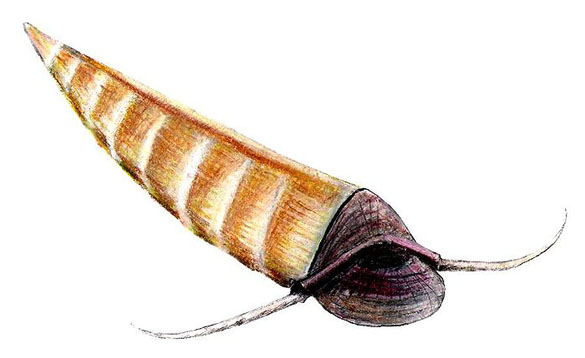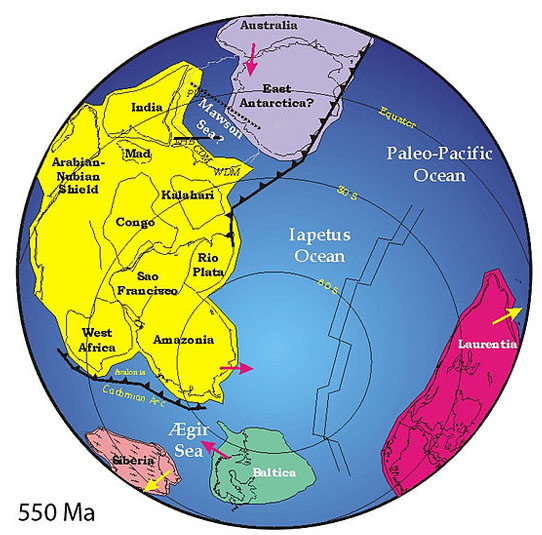 The fossils above are about as simple as fossils can be. They are internal molds (sediment-fills) of conical shells that were made of the carbonate mineral aragonite. The aragonite shells dissolved away after death and burial, leaving the cemented sediment behind. While not complex, these fossils have historic value in paleontology. They represent an extinct group called hyoliths, and they were found where the very first hyoliths were described by Eichwald in 1840: the Middle Ordovician of Estonia. I collected them on my first field trip to the Baltic States in 2006. (My original interest in picking them up, by the way, was in the faint squiggles on the outside of the molds — a trace fossil known as Arachnostega.)
The fossils above are about as simple as fossils can be. They are internal molds (sediment-fills) of conical shells that were made of the carbonate mineral aragonite. The aragonite shells dissolved away after death and burial, leaving the cemented sediment behind. While not complex, these fossils have historic value in paleontology. They represent an extinct group called hyoliths, and they were found where the very first hyoliths were described by Eichwald in 1840: the Middle Ordovician of Estonia. I collected them on my first field trip to the Baltic States in 2006. (My original interest in picking them up, by the way, was in the faint squiggles on the outside of the molds — a trace fossil known as Arachnostega.)
Hyoliths are rather common in some rock sequences. They are among the earliest shelly fossils known, found in the lowest Cambrian rocks (about 540 million years old). They peaked in abundance in the Cambrian and lived throughout the Paleozoic Era, finally going extinct at the end of the Permian Period (around 250 million years ago).
For as many hyolith fossils we have, they remain an enigmatic group. They had conical shells, usually a bit flattened, with a hinged lid (operculum) over the open end. Extending from the space between the operculum and cone were two calcareous rods called helens (a name deliberately chosen so as not to evoke a particular function). Some rare hyolith fossils show evidence of internal features, including muscle scars and a twisted intestinal tract. We still can’t definitely place them in a particular animal group, though, and even their life habits are obscure. They probably were deposit-feeders (digesting organic material from seafloor mud), but the support for this is speculative.
The hyoliths of Estonia tell us one more thing: they are different enough from other hyoliths around the world to show us that the paleocontinent of Baltica likely had its own biogeographic province. In other words, Baltica was isolated as an island continent during the Middle Ordovician (around 460 million years ago), much like Australia today.





…they are different enough from other hyoliths around the world…
That they are; those things are monsters!
The ones from the Mid. Ord. of Laurentia that I find are only a few milimeters.
Professor Mark Wilson,
I believe I may have found some examples of Hyoliths in Permian siltsone (~250 myo) on the Shoalhaven region of coastal NSW, Australia. Several Aust palaeontologists have suggested these specimens may be Hyoliths but are loathe to come up with a definitive id. I know that 250 myo would be at the end of the Hyolith era and that they would normally be found in limestones, not siltstone. Would I be able to post you some photos of these specimens ?
Kind regards, Dr. Bill Crozier
Sure, Bill, you can send me images. Sounds interesting. My address is mwilson@wooster.edu